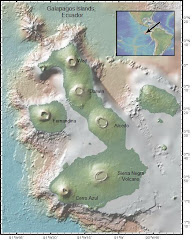 |
| Time for Tortoises |
The Giant Tortoises of the Galapagos were hunted almost to extinction by humans. They were easy to catch and an excellent food source for sailors on long voyages. Today they are protected from humans but face threats and competition from introduced species like rats, and feral goats and pigs. So, baby tortoises are raised at the Darwin Research Center for about five years. When they are large enough to be safe from predators, they are repatriated to their native islands. As we were siting our final seismic station at Caleta Iguana on the south flank of Cera Azul volcano, we watched the Galapagos Park Service load tortoises onto a helicopter for the trip back to their native volcano. On this day, I spent a few moments with a tour group watching the young tortoises, each with a number painted on its back. Then, I tried to hurry back to the work group and accidentally took a wrong path. I ended up peaking over a wooden fence just as the Giant Tortoises were waking up and stretching for the new day. When they saw me, three of them seem to strike a pose on their rock, stretching their necks for my camera.
The mission of the Charles Darwin Foundation is to ensure the conservation of the environment and biodiversity in the Galapagos Archipelago by providing knowledge and assistance through scientific research. For the three days that we were in and out of the Darwin Research Center organizing and preparing for our expedition we observed a steady stream of tourists from all over the world visiting the Center to learn about biodiversity, conservation and the endemic species of the Galapagos. This is the first stop for all tour groups. The education one receives here enriches the experience of traveling through the islands and also helps to slow the introduction of invasive species to this unique place.
But, in case education isn’t enough, all of our luggage and equipment spent an entire day in quarantine. Each and every piece of clothing we had was examined and checked for seeds, dirt and insects. Everything was placed in a special room and sprayed with insecticide. We wouldn’t be transporting even one mosquito to Isla Isabela.
Links to more information about conservation in the Galapagos:
Charles Darwin Foundation http://www.darwinfoundation.org/english/pages/index.php
Galapagos Conservancy http://www.galapagos.org/2008/index.php
Galapagos Conservation Trust http://www.gct.org/index.html
Galapagos National Park http://www.galapagosonline.com/Galapagos_Natural_History/National_Park/National_Park.html
